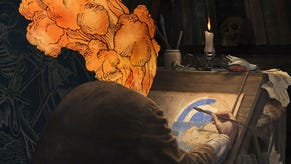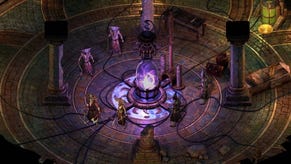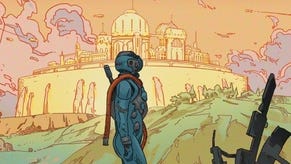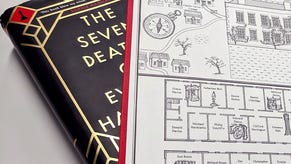Pillars of Eternity review
To Infinity, and beyond!
Easily the best thing about all these old-school RPG revivals has been remembering just how varied the classics truly were. Divinity Original Sin brought back the Ultima VII vibe, Wasteland 2 carried as much of Fallout as it did its namesake, and now Pillars of Eternity casts its resurrection spell on the classic that largely saved the genre from a descent into obscurity - Silver! No, wait. That other one. Baldur's Gate, that's it.
Pillars of Eternity isn't Baldur's Gate 3, but only because of a few technicalities like the name. Its new world is distinct from Forgotten Realms in detail rather than spirit, its engine and mechanics are patterned almost entirely after what BioWare and Black Isle were doing with the Infinity Engine back in the 90s. The backgrounds, higher resolution and with nicer effects, but cut from the same cloth. Each Act beginning with a portentous narrated text scroll. The map. The assassins out for your blood. The progression through small towns suffering from a background threat (this time to children rather than iron) before entering a big city of politics and intrigue. To be sure, you can find the individual elements there in many RPGs, but in this case the particular mix leaves no doubt as to what you're supposed to be feeling nostalgic about. And if any doubt persists, it's soon beaten over the head with the magic words "You must gather your party before venturing forth."
Occasionally, that can be a mite underwhelming. Part of what made Pillars' inspirations classics is that for their time, they were scrappy, adventurous, forging new terrain. The same has always gone for Obsidian's designs, being noted for their subversions and risk-taking and willingness to try spinning things in new directions even with existing franchises. Pillars of Eternity however, while ambitious, plays things very, very safe. It's absolutely the game that Obsidian's Kickstarter backers wanted and paid for, just lacking the company's usual flair for also giving us what we didn't know we wanted, or even the shake-ups to the formula supposedly made for the originally planned Baldur's Gate 3: The Black Hound. At times, it almost seems to pull away from its own twists. The occasional breaks from the action for Choose Your Own Adventure style storylets for instance sounded like a great idea for handling more complex encounters than the engine can offer, but in practice are typically "Try throwing a grappling hook? Okay, cool, it worked." I really wanted more of these, and more ambitious ones. The few that stand out really show their potential.
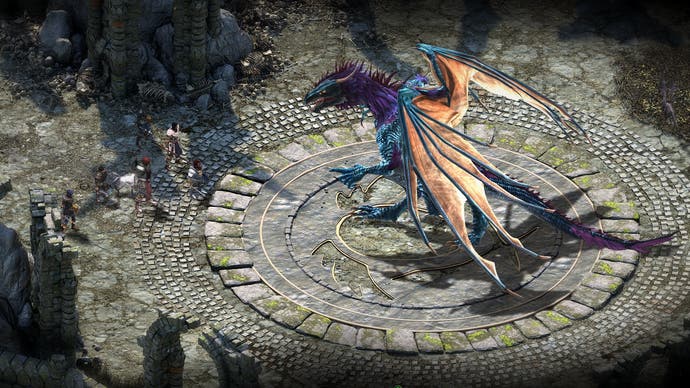
Being exactly what over 73,000 people stumped up four million dollars to play is hardly a sin though, and the obvious advantage of Obsidian knowing exactly what Pillars of Eternity had to be is that it's a far more polished, content-rich, and let's be honest here, finished game than most that have worn its logo. It's also a damn fine RPG. Being spiritually rooted in the Baldur's Gate era may dictate much of its design, but it comes with the benefit of another 15 or so years of experience, as well as machines that no longer have to make the same trade-offs. To take visuals as an easy example, Pillars' style is more grounded in its charms than other RPGs out there, even old-school ones, but everything is carefully done and with very effective details. A cave entrance where bloody corpses have been dragged. A terrain sprinkled with jade structures (technically 'adra', but that's not a helpful description) spearing through caves and quiet parts of the countryside, adding contrast to the familiar and tying into the more interesting bits of lore. It's easy to get absorbed in its world of familiar towns and villages in a land of much older magic, with the overall atmosphere being the Baldur's Gate that lives in your head, rather than the much clunkier reality of 1998.
The main twist on the story side is Pillars' focus on reincarnation, with the main character's magic RPG power of the day being the ability to speak with the dead and draw out the memories of souls - to pick up a bloody scarf and witness the sad story behind it, or solve a murder with the help of a dead man's confession. It's a clever gimmick, though I found much of the story and character of the world completely drowned out by Pillars of Eternity's obsession with its own lore. At times it seems like the Dyrwood national pastime is reciting history to every passing stranger, and even when not, this is a very dry, humourless game for the most part. Tastes vary of course, and there's nothing wrong with a stock fantasy setting played straight, but I soon longed for a Minsc or a Morte to lighten the mood and add a spark more humanity to the action. Quests are fairly stock, characters forgettable, and even the longest serving party members made little impact on me. Certainly, despite the Planescape Torment style premise of the soul stuff, this is no Planescape Torment.
Mechanically though, things are always interesting. Pillars of Eternity often feels like D&D if D&D had been designed around CRPGs instead of table-top, taking advantage of the PC handling the numbers to create things like the Chanter class, which cues up learned songs and sings them during battles to provide a stream of buffs and debuffs. Fairly early on you also get your own stronghold, a run-down castle called Caed Nua, complete with a massive dungeon full of horrors and a long list of repairs to make. They're all easily accomplished by just throwing money at them, which is never in short supply, but it's cool to see it visually returning to glory one piece at a time, with new opportunities, off-screen missions for idle party members and incoming visitors offering a decent incentive to keep popping back to see what's going on. Its dungeon, the Endless Paths, also offers a proper deep-down challenge that proves once and for all that if a ghost warns you not to casually jump into a sacrificial blood pit, then it's really, really best to listen to its expertise.
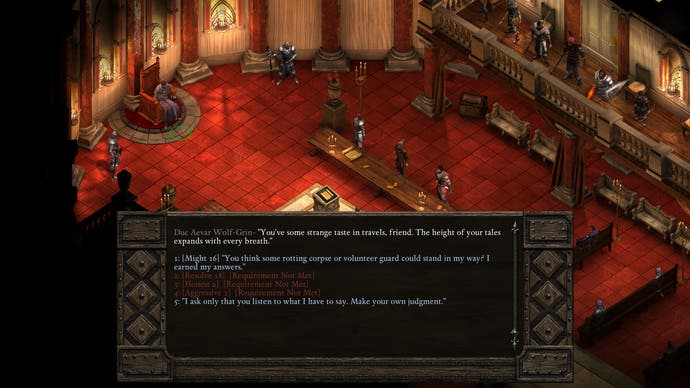
When adventuring, Pillars of Eternity also puts a heavy focus on playing 'properly'. Character status is split into Endurance and Health to factor in short and long term combat readiness (with no resurrection if a character dies, though it takes more than one unlucky critical hit), and there's no cheap resting after every fight whether they're half dead or just took a tiny little nick on the buttocks. Instead, resting needs Camping Supplies, and you can only carry a handful at any time. Usually this isn't a problem, since when invading an area you can always go back through cleared terrain and restock. When facing opposition between you and the exit though, say, after stealing something from deep in a temple, every rest-stop becomes precious.
The opposition is nothing to sniff at either. Pillars of Eternity is very much aimed at Infinity veterans, with even Easy/Normal modes (I was playing on Normal, but even that openly states that it only forgives a few things) often brutal. Wizards for instance, mechanically closer to the earlier games' Sorcerers despite their need to fill their grimoires with new spells, deal friendly fire damage, with even later magic missiles having areas of effect. There's no party AI/scripting either, demanding serious micromanagement to prevent most fights lasting longer than a quick BONK! SPLAT! ending with a quick and painful party kill. It often feels like real-time that would have been better off just being turn-based, heretical as that absolutely is.
This of course is all very much a hold-over from original Infinity Engine combat, and a good victory against the odds is as satisfying as a total party kill can be frustrating. Now as then though, it can also be annoying when encounters go from tactical battle to chaotic scuffle, with fighters casually running right through hot beams of magic death and the priest trapped and unable to get close enough to lay down some heals. It's doubly irritating when it's the fault of dodgy pathfinding or being blocked by other party members, with more than a few occasions where it's not clear whether or not you're ready for an encounter until it squishes you.

Pillars of Eternity does have some heart though, and makes a few concessions to the difficulty of controlling a whole party. Most characters can be built with at least a decent range of passive skills for instance, and as well as pausing, there's a slow-mo mode. It's also not necessary to fight literally everything, with a scouting mode giving all characters some degree of stealth, and XP coming primarily from completing quests. This isn't a game where you can avoid all fights, or even most of them, but there's often at least some way to talk down enemies, organise a ceasefire between rival factions with intelligence, or pull rank that you've earned in other quests to make someone listen instead of automatically reaching for a sword.
Perhaps most usefully of all, you can always get the party members you need. Early on for instance I had no fighter in a painfully squishy team, and couldn't find any convenient NPCs. Go into any tavern though and you can 'recruit' anyone you like for not much money, using the full character creation system instead of simply picking a prefab. You're also never, ever short of money after the first few areas. Along with the characters' tiny inventories comes a magical Stash that hoovers up all loot, and can be accessed at any time. Selling the hundreds of swords and armour sets you just get through regular combat soon means being able to repair an entire castle just to have something to do with the money, while by the third act, the greatest threat to the world is your party's brutal assault on the economy. At least, it should be. Evil cults? Pfft. Amateurs.
In keeping so close to the Baldur's Gate/Infinity Engine template, Pillars of Eternity can't help but inherit a few old flaws, and it would have been nice to see a bit more personality of its own shine through its carefully traditional design and shell. That said, what most stands out is just how well it manages to modernise the experience of playing those games and stand apart from them as an epic adventure in its own right. It's an RPG with design firmly rooted in nostalgia, but one that absolutely doesn't rely on it to be enjoyable today. Instead, it's both a great reminder of why those games worked so well, and a brand new adventure well worth the hours upon hours (upon hours upon hours) that it takes to pick away at its secrets and its world.



